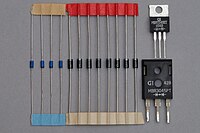
Photo from wikipedia
Ambient backscatter communication (AmBC) addresses connectivity, cost, and congestion bottlenecks for the Internet of Things (IoT) deployment. AmBC, by avoiding a dedicated power infrastructure and carrier emitter, allows tags to… Click to show full abstract
Ambient backscatter communication (AmBC) addresses connectivity, cost, and congestion bottlenecks for the Internet of Things (IoT) deployment. AmBC, by avoiding a dedicated power infrastructure and carrier emitter, allows tags to communicate by simply reflecting the ambient radio frequency (RF) signals to the reader. Thus, the tag can operate in the low-maintenance, battery-free mode and with energy harvesting. However, a fundamental bottleneck is the limited communication range. A novel solution is that the tag can use a tunnel diode amplifier to enhance its backscattered signal power and thus extend the communication range. This paper studies the tunnel diode amplifier solution and investigates the resulting capacity performance. Specifically, we first develop the system’s mathematical model, elaborate on the tunnel diode’s amplification mechanism, and derive its reflection gain. Subsequently, we derive the closed-form channel capacity and propose a reader-tag distance adjustment scheme to improve the system’s performance. Finally, simulation results corroborate our theoretical results. They show that the tunnel diode amplifier can significantly increase the system capacity by an order of magnitude when the tag receives less than -30 dBm of incident RF signal power. They also demonstrate a significant increase in the communication range.
Journal Title: IEEE Access
Year Published: 2022
Link to full text (if available)
Share on Social Media: Sign Up to like & get
recommendations!